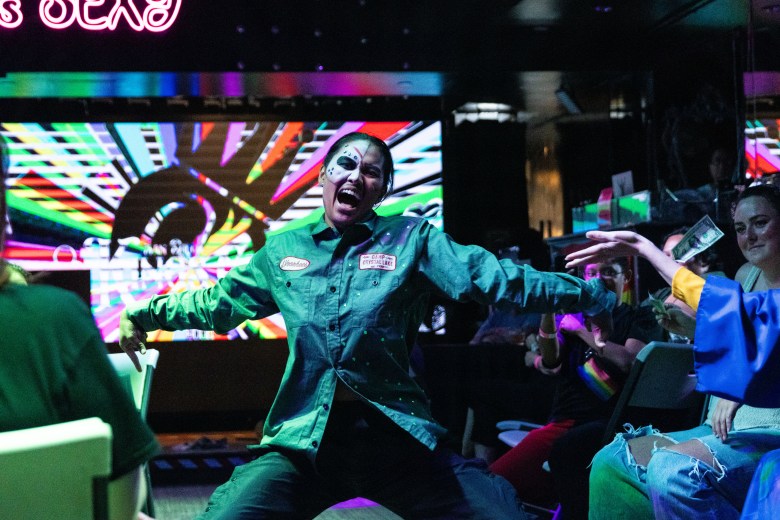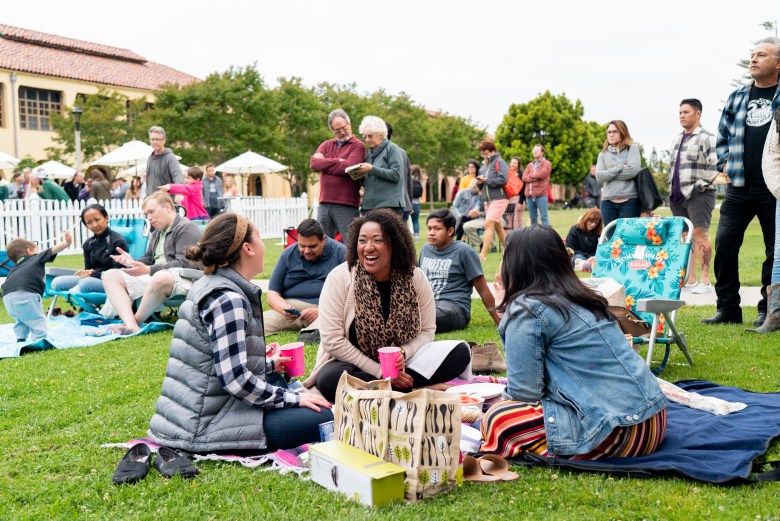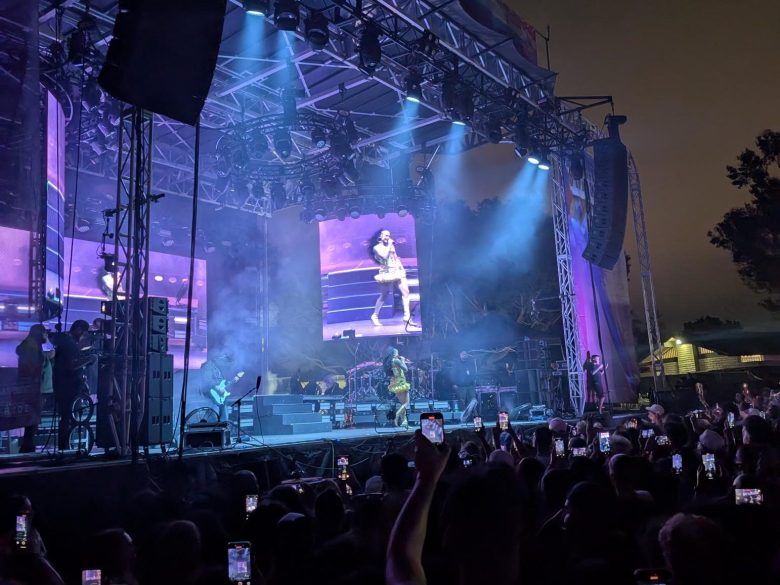HILLCREST – It’s 8 p.m. on a Friday night and the hoedown song “Drag King Bar” is blaring through the speakers at Gossip Grill in Hillcrest.
This is the traditional opening to the San Diego Kings Club show. Return audience members stomp and clap to the music, while tables of newcomers look on as the host, Ajax, takes the stage.
Ajax’s job is to prep the crowd. Some people here have never seen a drag king before – even though San Diego’s own Kings Club claims the title of longest-running troupe of its kind in America.
The Kings Club has been a mainstay of San Diego’s queer women’s bars for 25 years, enduring as different venues opened, closed and changed. The troupe even survived a period when there were no lesbian bars in the region.
In that time, the art of the performance has changed, too.
In an overly simplistic sense, drag kings mirror drag queens. Where the stock image of a drag queen is a man creating the illusion of being female, historically drag kings were largely women performance artists entertaining as male impersonators.
The reality is far more complex, and today’s drag kings say their personas play with aggrandized masculinity and gender stereotypes through a wide array of acts – singing, lip syncing, dancing, comedy and more.
“Drag is an artistic medium in the same way that drawing, painting, dancing, singing is,” said drag king Sam Paguita, 29, who does not connect their drag persona with their legal name to avoid scrutiny from potential employers. Paguita began performing online during the pandemic and is now a regular in shows each month at Gossip Grill.
Drag kings hold a significant place in LGBTQ+ history.
Stormé DeLarverie, a male impersonator seen today as a drag king, scuffled with police during a raid of a gay bar in New York in 1969. The scuffle led to a series of spontaneous uprisings that became known as a rebellion, and the site – the Stonewall Inn – became the launching point of the modern gay rights movement.
Despite drag kings’ history, the entertainment form is often overshadowed by the image of the drag queen. San Diego-raised RuPaul brought drag queens to the masses through a reality TV media empire. Today, drag kings say that tradition of lip syncing with exaggerated feminine gender performance both defined and limited the medium.
Rituals like the San Diego Kings Club show – which will celebrate its 25th anniversary in September – offer a whole different picture.
“We always have a good time,” says Jolene Sebastian, has followed the troupe faithfully for decades. Sebastian holds a dollar in the air as the kickoff act takes the stage.
It’s a special night for the performer, who is known both on- and off-stage as Rudy Ramrod. He is the only founding member of the Kings Club who still performs with the troupe. It’s also the celebration of Ramrod’s 61st birthday.
Ramrod emerges with a puffy goatee, lipsyncing to Disturbed’s cover of the political anthem “Land of Confusion.” (Drag, as Ajax reminded the crowd, has always been inherently political, as choosing joy in queer performance becomes a form of resistance.)
Halfway through the number, Ramrod rips off a buttoned-up shirt to reveal a T-shirt emblazoned with “Drag is not a crime” in trans flag colors. He begins to play air guitar. The crowd goes wild.
“These people have never seen a king before,” he said in an interview. “I just gave them that, and that makes me really happy.”
Origins
The history of Kings Club starts with a frustrated performer.
Get Uptown News in your inbox – community news that connects and informs.
Sign up to get free Uptown San Diego news weekly – along with the Times of San Diego daily at 8 a.m. and breaking news. Update at any time. By clicking sign up, you agree to the
terms
.
Kelly Harper, a bartender at a now-defunct lesbian bar called the Flame had an on-stage persona named Chess Rockwell. But local drag contests favored established queens. So Harper started a Wednesday drag king contest at the Flame. Random audience members were the judges. Winners weren’t allowed to re-enter, so new performers could have a chance.
Rockwell collected the winners of those weekly contests and formed a troupe of seven kings who performed each Friday, starting in September 2000.
“It was like a ritual. Everyone would show up on Friday nights to watch the drag king show,” recalled Moe Girton, a former Flame bartender.
When the 20-year-old bar closed in 2004, the troupe moved to another women’s bar and added new members after a different style of contest. The troupe continued to evolve as venues changed.
“There have been other groups that have tried. … They just don’t have the staying power and the success we’ve had,” said Lisa Raye, who attended a Kings Club show in 2013 and met one of the performers, Ramrod. Today, they’re married. She goes by Lisa Raye – her first and middle names – as an onstage persona.
As San Diego endured a period with no lesbian bars, the club had to advocate for space for itself at a series of gay men’s bars.
“We’ve had very, very lean times,” said Raye, 48, who performs and is stage manager for the troupe. At one men’s bar there were “five people— and that included the performers.”
Ramrod brought drag performer Ajax on to host, who encouraged him to keep going despite the struggle to find a home.
After yet another bar was set to close, the troupe knew it needed a home in a women’s bar. Gossip Grill, known as one of the only lesbian bars in California since its opening in 2009, had moved to a space large enough for performances. In 2015, Ramrod approached the owner – Girton, the former bartender from the Flame.
The Kings Club became the bar’s first regular drag show. According to Girton, it still sells out every month.
“It just was a rebirth. It’s the right place for us,” Ramrod said. “The show started really exploding again.”
Changing faces
Get neighborhood news in your inbox. It’s free and enlightening.
Join the 20,000+ people who get Times of San Diego in their inbox at 8 a.m. every day – plus breaking news alerts.
We’ve also added weekly updates from San Diego neighborhoods! By clicking sign up, you agree to the
terms
. Select below.
The lifespan of Kings Club also has seen new kinds of performers emerge.
After shows, Ramrod frequently gets approached by people who want to try out drag. Interest exploded after the pandemic, far beyond the guest slots an entire year’s worth of shows could hold.
A new fourth Friday show was launched, Kings and Friends, which lets any interested drag performer take the stage.
Ramrod and other longtime performers noted that the acts that emerged also departed from the classic king persona he embodies.
“Rudy comes from the generation where you needed to have that over-the-top male persona, like the Marlboro Man,” said Ajax. The 49-year-old performer declined to be identified beyond that name.
Performers from that era projected their images as heterosexual men. Today’s acts encompass more wide-ranging identities.
“The point of this is not to pass as a man,” said TJ Barr, 31, the stage name of Kaylin Saur, who hosts Kings and Friends. “The point of this is to tell a story.”
New performers still find joy on stage, whether in ridiculous musical or political theater numbers.
At the Kings and Friends show June 27, one of the newest performers, Scott Cooties, dressed as Elon Musk and sang a breakup song to a heart-shaped cutout of President Trump. Being venerated as a king is especially meaningful for Cooties, 36, who is transgender and asked not to be identified beyond his stage name.
“In my day-to-day life, I’m still really perceived as a woman, even trying not to be. Being able to be Scott and be perceived as part of myself really gives me that opportunity to experience gender euphoria.”
Rudy Ramrod credits the transgender rights movement for the change in drag culture.
“People started realizing,” he said, that you’ve “just got to be yourself.”
The Kings Club will hold its 25th anniversary show on Sept. 12 at Gossip Grill.

 by
by 

